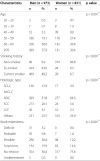1. Doll R, Peto R. The causes of cancer: quantitative estimates of avoidable risks of cancer in the United States today. J Natl Cancer Inst. 1981; 66:1191–1308. PMID:
7017215.
4. Papadopoulos A, Guida F, Leffondré K, Cénée S, Cyr D, Schmaus A, Radoï L, Paget-Bailly S, Carton M, Menvielle G, Woronoff AS, Tretarre B, Luce D, Stücker I. Heavy smoking and lung cancer: are women at higher risk? Result of the ICARE study. Br J Cancer. 2013; 110(5):1385–1391. DOI:
10.1038/bjc.2013.821. PMID:
24423926.
5. Elci OC, Akpinar-Elci M, Alavanja M, Dosemeci M. Occupation and the risk of lung cancer by histologic types and morphologic distribution: a case-control study in Turkey. Monaldi Arch Chest Dis. 2003; 59(3):183–188. PMID:
15065312.
6. MacArthur AC, Le ND, Fang R, Band PR. Identification of occupational cancer risk in British Columbia: a population-based case-control study of 2,998lungcancers by histopathological subtype. Am J Ind Med. 2009; 52(3):221–232. DOI:
10.1002/ajim.20663. PMID:
19058264.
7. Baker EL, Honchar PA, Fine LJ. Surveillance in occupational illness and injury: concepts and content. Am J Public Health. 1989; 79(Suppl 9):9–11. DOI:
10.2105/AJPH.79.Suppl.9. PMID:
2817212.
8. Chang SS, Kim SY. Contact dermatitis surveillance system in Taejon city: Prevalence of contact dermatitis among the workers exposed to solvents and nonmetallic chemicals through an immediate health examination system in Taejon city. Korean J Occup Environ Med. 2000; 12(2):227–234.
9. Jeong WC, Kwon HJ, Ha M, Roh SC, Kwon BS, Hyun JG, Lee SJ, Lee JM, Kwon JY, Kim JS, Baek NJ, Lee H, Lee KW, Lee SK. Surveillance of work-related carpal tunnel syndrome in Korea. Korean J Occup Environ Med. 2004; 16(1):37–47.
10. Kim SA, Kim JS, Jeon HR, Jung SJ, Kim SW, Lee CY, Ham JO, Yoo JY, Choi TS, Goo HB, Cho MH, Woo KH. Surveillance of work-related diseases in Kumi. Korean J Occup Environ Med. 2003; 15(1):95–110.
11. Kim JI, Kim BG, Kim JW, Chae CH, Yi CH, Kang D, Kim JH, Kim JH, Kim YW, Lee YH, Lee JH, Choi Y, Kim JH, Yun HR, Yoo CI, Jeong BG, Jang TW, Kim YG, Yun DY, Kang JU, Kim JE, Ahn JH, Lee DJ, Jang JH, Lee KY, Song HR, Lee YH, Cho BM. Occupational disease surveillance system in Busan, Ulsan, Kyung-Nam area. Korean J Occup Environ Med. 2003; 16(1):1–12.
12. Bondy SJ, Victor JC, Diemert LM. Origin and use of the 100 cigarette criterion in tobacco surveys. Tob Control. 2009; 18(4):317–323. DOI:
10.1136/tc.2008.027276. PMID:
19491091.
13. Rushton L, Hutchings SJ, Fortunato L, Young C, Evans GS, Brown T, Bevan R, Slack R, Holmes P, Bagga S, Cherrie JW, Van Tongeren M. Occupational cancer burden in Great Britain. Br J Cancer. 2012; 19(Suppl 1):S3–S7. DOI:
10.1038/bjc.2012.112. PMID:
22710676.
14. Driscoll T, Nelson DI, Steenland K, Leigh J, Concha-Barrientos M, Fingerhut M, Prüss-Ustün A. The global burden of disease due to occupational carcinogens. Am J Ind Med. 2005; 48(6):419–431. DOI:
10.1002/ajim.20209. PMID:
16299703.
15. LaDou J. The asbestos cancer epidemic. Environ Health Perspect. 2004; 112(3):285–290. DOI:
10.1289/ehp.6704. PMID:
14998741.
16. Hillerdal G, Hendeerson DW. Asbestos, asbestosis, pleural plaques and lung cancer. Scand J Work Environ Health. 1997; 23(2):93–103. DOI:
10.5271/sjweh.186. PMID:
9167232.
18. Park J, Hisanaga N, Kim Y. Transfer of occupational health problems from a developed to a developing country: lessons from the Japan-South Korea experience. Am J Ind Med. 2009; 52(8):625–632. DOI:
10.1002/ajim.20723. PMID:
19562727.
19. Straif K, Benbrahim-Tallaa L, Baan R, Grosse Y, Secretan B, El Ghissassi F, Bouvard V, Guha N, Freeman C, Galichet L, Cogliano V; WHO International Agency for Research on Cancer Monograph Working Group. A review of human carcinogens-part C: metals, arsenic, dusts, and fibres. Lancet Oncol. 2009; 10(5):453–454. DOI:
10.1016/S1470-2045(09)70134-2. PMID:
19418618.
22. Blair A, Grauman DJ, Lubin JH, Fraumeni JF Jr. Lung cancer and other causes of death among licensed pesticide applicators. J Natl Cancer Inst. 1983; 71(1):31–37. PMID:
6575207.
23. Alavanja MC, Dosemeci M, Samanic C, Lubin J, Lynch CF, Knott C, Barker J, Hoppin JA, Sandler DP, Coble J, Thomas K, Blair A. Pesticides and lung cancer risk in the agricultural health study cohort. Am J Epidemiol. 2004; 160(9):876–885. DOI:
10.1093/aje/kwh290. PMID:
15496540.
25. Lubin JH, Blot WJ. Assessment of lung cancer risk factors by histologic type. J Natl Cancer Inst. 1984; 73(2):383–389. PMID:
6087006.
27. Devesa SS, Shaw GL, Blot WJ. Changing patterns of lung cancer incidence by histological type. Cancer Epidemiol Biomarkers Prev. 1991; 1(1):29–34. PMID:
1845165.
28. Zahm SH, Brownson RC, Chang JC, Davis JR. Study of lung cancer histologic types, occupation, and smoking in Missouri. Am J Ind Med. 1989; 15(5):565–578. DOI:
10.1002/ajim.4700150509. PMID:
2741962.







 PDF
PDF Citation
Citation Print
Print



 XML Download
XML Download